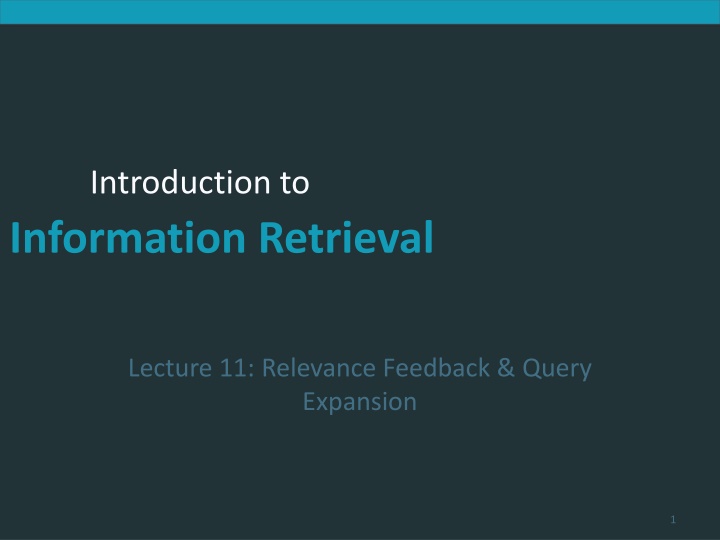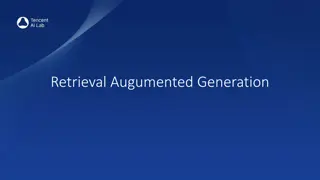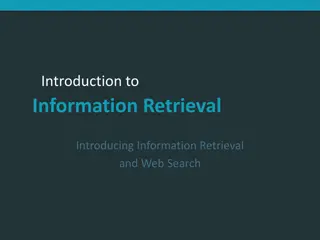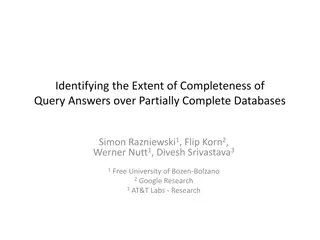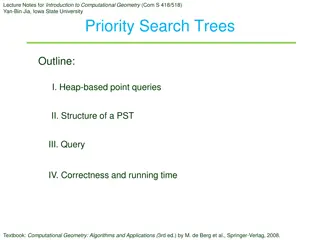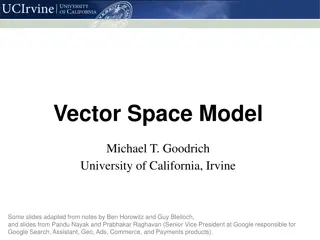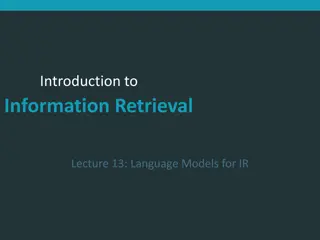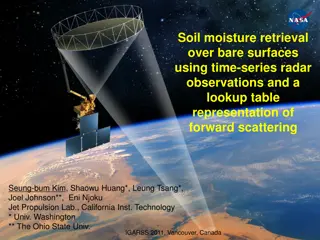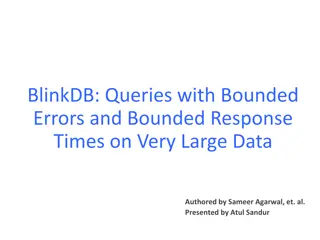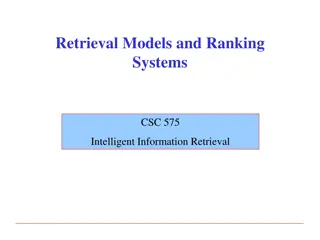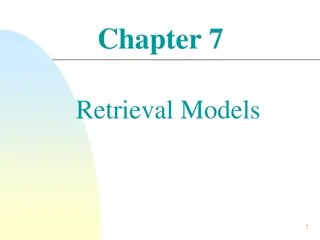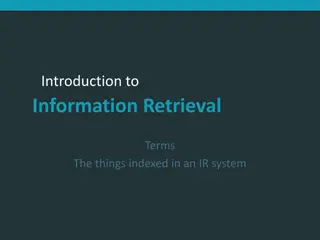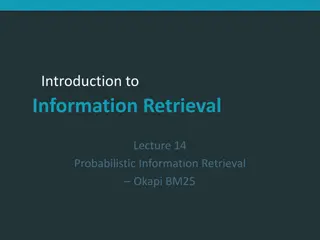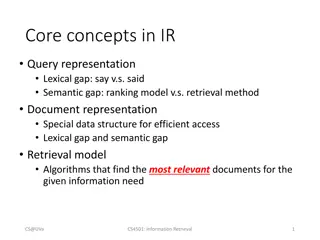Relevance Feedback & Query Expansion in Information Retrieval
This content delves into the concepts of relevance feedback and query expansion in information retrieval. It covers interactive methods to improve initial search results, such as Rocchio feedback and adding synonyms to queries. Ways to enhance recall in search by increasing relevant document retrieval are explored, along with local and global approaches to improving recall. The importance of user feedback in refining search results is highlighted throughout.
Download Presentation

Please find below an Image/Link to download the presentation.
The content on the website is provided AS IS for your information and personal use only. It may not be sold, licensed, or shared on other websites without obtaining consent from the author.If you encounter any issues during the download, it is possible that the publisher has removed the file from their server.
You are allowed to download the files provided on this website for personal or commercial use, subject to the condition that they are used lawfully. All files are the property of their respective owners.
The content on the website is provided AS IS for your information and personal use only. It may not be sold, licensed, or shared on other websites without obtaining consent from the author.
E N D
Presentation Transcript
Introduction to Information Retrieval Introduction to Information Retrieval Lecture 11: Relevance Feedback & Query Expansion 1
Introduction to Information Retrieval Take-away today Interactive relevance feedback: improve initial retrieval results by telling the IR system which docs are relevant / nonrelevant Best known relevance feedback method: Rocchio feedback Query expansion: improve retrieval results by adding synonyms / related terms to the query Sources for related terms: Manual thesauri, automatic thesauri, query logs 2 2
Introduction to Information Retrieval Overview Motivation Relevance feedback: Basics Relevance feedback: Details Query expansion 3
Introduction to Information Retrieval Outline Motivation Relevance feedback: Basics Relevance feedback: Details Query expansion 4
Introduction to Information Retrieval How can we improve recall in search? Main topic today: two ways of improving recall: relevance feedback and query expansion As an example consider query q: [aircraft] . . . . . . and document dcontaining plane , but not containing aircraft A simple IR system will not return d for q. Even if d is the most relevant document for q! We want to change this: Return relevant documents even if there is no term match with the (original) query 5 5
Introduction to Information Retrieval Recall Loose definition of recall in this lecture: increasing the number of relevant documents returned to user 6 6
Introduction to Information Retrieval Options for improving recall Local: Do a local , on-demand analysis for a user query Main local method: relevance feedback Part 1 Global: Do a global analysis once (e.g., of collection) to produce thesaurus Use thesaurus for query expansion Part 2 7 7
Introduction to Information Retrieval Outline Motivation Relevance feedback: Basics Relevance feedback: Details Query expansion 8
Introduction to Information Retrieval Relevance feedback: Basic idea The user issues a (short, simple) query. The search engine returns a set of documents. User marks some docs as relevant, some as nonrelevant. Search engine computes a new representation of the information need. Hope: better than the initial query. Search engine runs new query and returns new results. New results have (hopefully) better recall. 9 9
Introduction to Information Retrieval Relevance feedback We can iterate this: several rounds of relevance feedback. We will use the term ad hoc retrieval to refer to regular retrieval without relevance feedback. We will now look at three different examples of relevance feedback that highlight different aspects of the process. 10 10
Introduction to Information Retrieval Example 3: A real (non-image) example Initial query: [new space satellite applications] Results for initial query: (r = rank) r + 1 0.539 NASA Hasn t Scrapped Imaging Spectrometer + 2 0.533 NASA Scratches Environment Gear From Satellite Plan 3 0.528 Science Panel Backs NASA Satellite Plan, But Urges Launches of Smaller Probes 4 0.526 A NASA Satellite Project Accomplishes Incredible Feat: Staying Within Budget 5 0.525 Scientist Who Exposed Global Warming Proposes Satellites for Climate Research 6 0.524 Report Provides Support for the Critics Of Using Big Satellites to Study Climate 7 0.516 Arianespace Receives Satellite Launch Pact From Telesat Canada + 8 0.509 Telecommunications Tale of Two Companies User then marks relevant documents with + . 11
Introduction to Information Retrieval Expanded query after relevance feedback 2.074 new 15.106 space 30.816 satellite 5.991 5.660 application 5.196 eos nasa 4.196 launch 3.972 aster Compare to original 3.516 3.004 instrument bundespost 3.446 arianespace 2.806 ss 2.790 rocket 2.053 scientist 2.003 0.836 broadcast oil 1.172 earth 0.646 measure query: [new space satellite applications] 12 12
Introduction to Information Retrieval Results for expanded query r * 1 0.513 NASA Scratches Environment Gear From Satellite Plan * 2 0.500 NASA Hasn t Scrapped Imaging Spectrometer 3 0.493 When the Pentagon Launches a Secret Satellite, Space Sleuths Do Some Spy Work of Their Own 4 0.493 NASA Uses Warm Superconductors For Fast Circuit * 5 0.492 Telecommunications Tale of Two Companies 6 0.491 Soviets May Adapt Parts of SS-20 Missile For Commercial Use 7 0.490 Gaping Gap: Pentagon Lags in Race To Match the Soviets In Rocket Launchers 8 0.490 Rescue of Satellite By Space Agency To Cost $90 Million 13
Introduction to Information Retrieval Outline Motivation Relevance feedback: Basics Relevance feedback: Details Query expansion 14
Introduction to Information Retrieval Key concept for relevance feedback: Centroid The centroid is the center of mass of a set of points. Recall that we represent documents as points in a high- dimensional space. Thus: we can compute centroids of documents. Definition: where D is a set of documents and is the vector we use to represent document d. 15 15
Introduction to Information Retrieval Centroid: Example 16 16
Introduction to Information Retrieval Rocchio algorithm The Rocchio algorithm implements relevance feedback in the vector space model. Rocchio chooses the query that maximizes Dr : set of relevant docs; Dnr : set of nonrelevant docs Intent: ~qopt is the vector that separates relevant and nonrelevant docs maximally. Making some additional assumptions, we can rewrite as: 17 17
Introduction to Information Retrieval Rocchio algorithm The optimal query vector is: We move the centroid of the relevant documents by the difference between the two centroids. 18 18
Introduction to Information Retrieval Exercise: Compute Rocchio vector circles: relevant documents, Xs: nonrelevant documents 19 19
Introduction to Information Retrieval Rocchio illustrated : centroid of relevant documents 20 20
Introduction to Information Retrieval Rocchio illustrated does not separate relevant / nonrelevant. 21 21
Introduction to Information Retrieval Rocchio illustrated centroid of nonrelevant documents. 22 22
Introduction to Information Retrieval Rocchio illustrated 23 23
Introduction to Information Retrieval Rocchio illustrated - difference vector 24 24
Introduction to Information Retrieval Rocchio illustrated Add difference vector to 25 25
Introduction to Information Retrieval Rocchio illustrated to get 26 26
Introduction to Information Retrieval Rocchio illustrated separates relevant / nonrelevant perfectly. 27 27
Introduction to Information Retrieval Rocchio illustrated separates relevant / nonrelevant perfectly. 28 28
Introduction to Information Retrieval Terminology We use the name Rocchio for the theoretically better motivated original version of Rocchio. The implementation that is actually used in most cases is the SMART implementation we use the name Rocchio (without prime) for that. 29 29
Introduction to Information Retrieval Rocchio 1971 algorithm (SMART) Used in practice: qm: modified query vector; q0: original query vector; Drand Dnr : sets of known relevant and nonrelevant documents respectively; , , and : weights New query moves towards relevant documents and away from nonrelevant documents. Tradeoff vs. / : If we have a lot of judged documents, we want a higher / . Set negative term weights to 0. Negative weight for a term doesn t make sense in the vector space model. 30 30
Introduction to Information Retrieval Positive vs. negative relevance feedback Positive feedback is more valuable than negative feedback. For example, set = 0.75, = 0.25 to give higher weight to positive feedback. Many systems only allow positive feedback. 31 31
Introduction to Information Retrieval Relevance feedback: Assumptions When can relevance feedback enhance recall? Assumption A1: The user knows the terms in the collection well enough for an initial query. Assumption A2: Relevant documents contain similar terms (so I can hop from one relevant document to a different one when giving relevance feedback). 32 32
Introduction to Information Retrieval Violation of A1 Assumption A1: The user knows the terms in the collection well enough for an initial query. Violation: Mismatch of searcher s vocabulary and collection vocabulary Example: cosmonaut / astronaut 33 33
Introduction to Information Retrieval Violation of A2 Assumption A2: Relevant documents are similar. Example for violation: [contradictory government policies] Several unrelated prototypes Subsidies for tobacco farmers vs. anti-smoking campaigns Aid for developing countries vs. high tariffs on imports from developing countries Relevance feedback on tobacco docs will not help with finding docs on developing countries. 34 34
Introduction to Information Retrieval Relevance feedback: Evaluation Pick one of the evaluation measures from last lecture, e.g., precision in top 10: P@10 Compute P@10 for original query q0 Compute P@10 for modified relevance feedback query q1 In most cases: q1 is spectacularly better than q0! Is this a fair evaluation? 35 35
Introduction to Information Retrieval Evaluation: Caveat True evaluation of usefulness must compare to other methods taking the same amount of time. Alternative to relevance feedback: User revises and resubmits query. Users may prefer revision/resubmission to having to judge relevance of documents. There is no clear evidence that relevance feedback is the best use of the user s time. 36 36
Introduction to Information Retrieval Relevance feedback: Problems Relevance feedback is expensive. Relevance feedback creates long modified queries. Long queries are expensive to process. Users are reluctant to provide explicit feedback. It s often hard to understand why a particular document was retrieved after applying relevance feedback. The search engine Excite had full relevance feedback at one point, but abandoned it later. 37 37
Introduction to Information Retrieval Pseudo-relevance feedback Pseudo-relevance feedback automates the manual part of true relevance feedback. Pseudo-relevance algorithm: Retrieve a ranked list of hits for the user s query Assume that the top k documents are relevant. Do relevance feedback (e.g., Rocchio) Works very well on average But can go horribly wrong for some queries. Several iterations can cause query drift. 38 38
Introduction to Information Retrieval Pseudo-relevance feedback at TREC4 Cornell SMART system Results show number of relevant documents out of top 100 for 50 queries (so total number of documents is 5000): method number of relevant documents lnc.ltc 3210 lnc.ltc-PsRF 3634 Lnu.ltu 3709 Lnu.ltu-PsRF 4350 Results contrast two length normalization schemes (L vs. l) and pseudo-relevance feedback (PsRF). The pseudo-relevance feedback method used added only 20 terms to the query. (Rocchio will add many more.) This demonstrates that pseudo-relevance feedback is effective on average. 39 39
Introduction to Information Retrieval Outline Motivation Relevance feedback: Basics Relevance feedback: Details Query expansion 40
Introduction to Information Retrieval Query expansion Query expansion is another method for increasing recall. We use global query expansion to refer to global methods for query reformulation . In global query expansion, the query is modified based on some global resource, i.e. a resource that is not query- dependent. Main information we use: (near-)synonymy A publication or database that collects (near-)synonyms is called a thesaurus. We will look at two types of thesauri: manually created and automatically created. 41 41
Introduction to Information Retrieval Query expansion: Example 42 42
Introduction to Information Retrieval Types of user feedback User gives feedback on documents. More common in relevance feedback User gives feedback on words or phrases. More common in query expansion 43 43
Introduction to Information Retrieval Types of query expansion Manual thesaurus (maintained by editors, e.g., PubMed) Automatically derived thesaurus (e.g., based on co- occurrence statistics) Query-equivalence based on query log mining (common on the web as in the palm example) 44 44
Introduction to Information Retrieval Thesaurus-based query expansion For each term t in the query, expand the query with words the thesaurus lists as semantically related with t. Example from earlier: HOSPITAL MEDICAL Generally increases recall May significantly decrease precision, particularly with ambiguous terms INTEREST RATE INTEREST RATE FASCINATE Widely used in specialized search engines for science and engineering It s very expensive to create a manual thesaurus and to maintain it over time. A manual thesaurus has an effect roughly equivalent to annotation with a controlled vocabulary. 45 45
Introduction to Information Retrieval Automatic thesaurus generation Attempt to generate a thesaurus automatically by analyzing the distribution of words in documents Fundamental notion: similarity between two words Definition 1: Two words are similar if they co-occur with similar words. car motorcycle because both occur with road , gas and license , so they must be similar. Definition 2: Two words are similar if they occur in a given grammatical relation with the same words. You can harvest, peel, eat, prepare, etc. apples and pears, so apples and pears must be similar. Co-occurrence is more robust, grammatical relations are more accurate. 46 46
Introduction to Information Retrieval Co-occurence-based thesaurus: Examples 47 47
Introduction to Information Retrieval Query Expansion: Examples Query Expansion: Examples 48
Introduction to Information Retrieval Query expansion at search engines Main source of query expansion at search engines: query logs Example 1: After issuing the query [herbs], users frequently search for [herbal remedies]. herbal remedies is potential expansion of herb . Example 2: Users searching for [flower pix] frequently click on the URL photobucket.com/flower. Users searching for [flower clipart] frequently click on the same URL. flower clipart and flower pix are potential expansions of each other. 49 49
